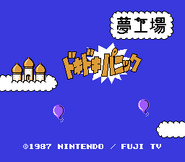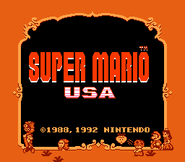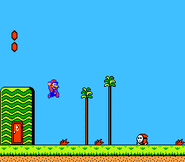Synopsis[]
This time it's a fierce action-packed battle to free the land of Sub-con from the curse of the evil Wart. It's up to you, along with Mario, Luigi, Toad and the Princess, to fight your way through bizarre multi-level worlds and find him! This time you've got a brand new kind of power -- plucking power -- and now anything you find can be a weapon. But beware! You've never seen creatures like these! Shyguys and Tweeters! Ninji and Beezos! And you've never had an adventure like this! Only cunning and speed can save you now...
From Nintendo Power Magazine #001:
It all started late one night when our hero, Mario, had a very strange dream. In his dream, he climbed up a long winding stairway leading to a door. When he opened the door, he saw a world unlike anything he had ever seen before. As he peered into this wondrous world, he suddenly heard someone say in a faint and distant voice, "Welcome to the World of Dreams, the land of Sub-con. We have been waiting for you, Mario. We want you and your friends to fight against the evil ruler, Wart, and bring peace back to the World of Dreams."
Development[]
On July 10, 1987, the game's origins were first seen in the Famicom Disk System title, Dream Factory: Doki Doki Panic, which was distributed by Fuji TV. In this game, the story begins with two kids reading a book, when a big green hand pops out and yanks them into the book. Their pet monkey runs off to find help. A family finds the book, then decides to jump into it and save the kids. The plot for SMB2 was completely changed to Mario having a strange dream which involves himself climbing up a long staircase leading up to a mysterious door.
Other differences include the following:
- In DDP, the character you selected has to be played throughout the entire game, while in SMB2, you can change your character after clearing a level.
- The Bonus Chance screen is green. However, the game is pretty much still the same.
- The playable characters are a brother, a mama, a sister and a papa.
- The music for the title screen, sub-space area and star invincibility are different. MIDIs for these sequences were uploaded to VGMusic on November 30, 2002.
- The grass is black.
- The potion is actually a magic lamp.
- The mushroom is actually a heart.
- The 1-UP mushroom is your character's head.
- The shell looks a lot like a black shrunken head.
- The Hawkmouth looks more like an Inca mask.
- When an explosion occurs, you now see "BOM" without the second B.
- Phanto's face is different.
- The Mushroom Blocks are just ordinary pick-up masks.
- The waterfalls go faster.
- The World 7 vegetable is different.
- There is a third Mouser in World 5-3, in place of Clawgrip.
- The characters' sizes still remain, even when there's one heart left in the meter.
These details were revealed on August 4, 1999 on TMK.
Characters[]
- Mario - His ability to jump is average, but he loses it a little bit when he carries an item.
- Luigi - He can spring up higher, but he greatly weakens if he has to carry an item.
- Toad - He is the worst jumper, but the weight of items does not hinder him one bit.
- Princess - She can float in the air for about 1.5 seconds if you hold down the A button.
In Other Languages[]
| Language | Title |
|---|---|
| Japanese | スーパーマリオUSA |
| Korean | 슈퍼 마리오 브라더스 2 |
Release timeline[]
| Console | Country of origin | Date |
|---|---|---|
| NES | USA | October 1988 |
| NES | UK | April 28, 1989 |
| NES | South Korea | 1989 |
| NES | Japan | September 14, 1992 |
| Wii | UK | May 25, 2007 |
| Wii | USA | July 2, 2007 |
| Wii | Japan | August 10, 2007 |
| Wii | South Korea | July 15, 2008 |
| Nintendo 3DS | Japan | November 28, 2012 |
| Wii U | USA/UK | May 16, 2013 |
| Nintendo 3DS | USA | July 11, 2013 |
| Nintendo 3DS | UK | August 7, 2013 |
| Wii U | Japan | March 19, 2014 |
| Nintendo 3DS | South Korea | March 2, 2016 |
As an .NES ROM file[]
| April 13, 1997 | Original (NTSC) version |
| December 10, 1999 | Japanese ("Super Mario USA") version |
| April 5, 2000 | Portuguese version |
| June 6, 2000 | European (PAL) version |
| October 8, 2003 | Spanish version |
| February 23, 2004 | French version |
Music[]
| Sequence Title | Original MIDI Release Date | |
|---|---|---|
| 1 | Title Screen | June 16, 2001 |
| 2 | Character Select | 1997 |
| 3 | Overworld | 1997 |
| 4 | Underground | 1997 |
| 5 | Sub-Space | October 22, 1997 |
| 6 | Boss Theme | July 5, 1998 |
| 7 | Bonus Chance | March 17, 2002 |
| 8 | Fanfare | March 17, 2002 |
| 9 | Miss | March 17, 2002 |
| 10 | Wart | February 20, 2000 |
| 11 | Boss Clear | July 26, 1998 |
| 12 | Game Over | March 17, 2002 |
| 13 | Ending | 1997 |
The Starman music is not listed here because it is very similar to how it plays in Super Mario Bros..
Weblinks[]
- http://www.nintendo.com/gamemini?gameid=HSm4x49FByECeL-kmPsmGCzuAyB2uhkY (July–November 2007)
- http://www.nintendo.com/wii/virtualconsole/games/detail/HSm4x49FByECeL-kmPsmGCzuAyB2uhkY (2007-2010)
- http://www.nintendo.com/games/detail/HSm4x49FByECeL-kmPsmGCzuAyB2uhkY (2010-2019)
- http://www.nintendo.com/games/detail/Yq01GCFWN-xWmq7Jv9-NFhVrAXMrsdVM (2013-2019)
- http://www.nintendo.com/games/detail/ZP3N5PNR_eZUQV43Ukwtbl-QauOYWNMC (2013-2019)
Gallery[]
Screenshots[]
See also[]









